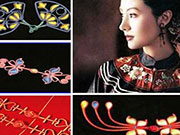Chinese-German woman contributes to cultural heritage

 0 Comment(s)
0 Comment(s) Print
Print E-mail CNTV, August 4, 2015
E-mail CNTV, August 4, 2015
The qipao is a quintessentially Chinese garment, embodying elegance and sophistication. But even the buttons can make a distinct contribution to culture. So-called 'frog buttons' are now listed as part of Shanghai's intangible cultural heritage, partly because of the efforts of a Chinese-German woman who spent 16 years developing them into an art form.
 |
|
The qipao is a quintessentially Chinese garment, embodying elegance and sophistication. But even the buttons can make a distinct contribution to culture. So-called 'frog buttons' are now listed as part of Shanghai's intangible cultural heritage, partly due to the efforts of a Chinese-German woman who spent 16 years developing them into an art form. |
Animals and Chinese knots are among the patterns Shan Lina uses in designing her buttons. Each of the buttons is made of silk of different colors. Shan says she became fascinated by the buttons when she returned to China from Germany and started a garment business in 1998. The original idea was to create unique clothes.
"In 1998, there were many Chinese clothes tailors in Shanghai. To stand out, we must be different. So we added more patterns and integrated more traditional Chinese patterns in the buttons. We then received more attention, so we felt we had more responsibility in the area, which stimulated us to design more," Shan said.
Over the past 16 years, Shan and her team have made nearly 10,000 such buttons, with themes ranging from characters, and plants to daily necessities. She said her main inspiration comes from Chinese culture and people's daily lives.
"I want to string all the things that represent good luck in China's history. So we select one symbolic thing from every dynasty to make buttons, such as bronze-ware from the Shang and Zhou dynasties, tiles in the fist half of the 20th century, and vehicles that people use in modern times," Shan said.
"I remember when I first entered the studio, I was deeply attracted by the beautiful buttons made by experienced teachers. I felt it was quite interesting and I didn't know how they were made. But as I learned more, I found it very hard and boring to do it. There were three of us learning this skill, only I stayed till now," said Song Tao, Chinese button artist.
Shan has passed her skills on to several students and she has also put on several exhibitions on the mainland, and in Hong Kong and France. Many people, including expats, want to buy her buttons, but she says they are not for sale. She wants to keep them all together in a collection and ensure they stay in China.
"I want to develop the skill in China, because it is a very traditional Chinese handicraft. I can bring them overseas, but it will be strange for me. When I brought them to Germany, they immediately recognize it is a Chinese handicraft. So I still want to keep it in its original place," Shan said.
Shan said her goal is to establish a museum for Chinese buttons in Shanghai, her hometown.
She is not alone in trying to protect the city's cultural heritage, and her problems are not unique either. The city is worried that more than 200 of its unique handcrafts will die out as few people are willing to learn the skills, which are difficult to master and unlikely to earn a good income.






Go to Forum >>0 Comment(s)